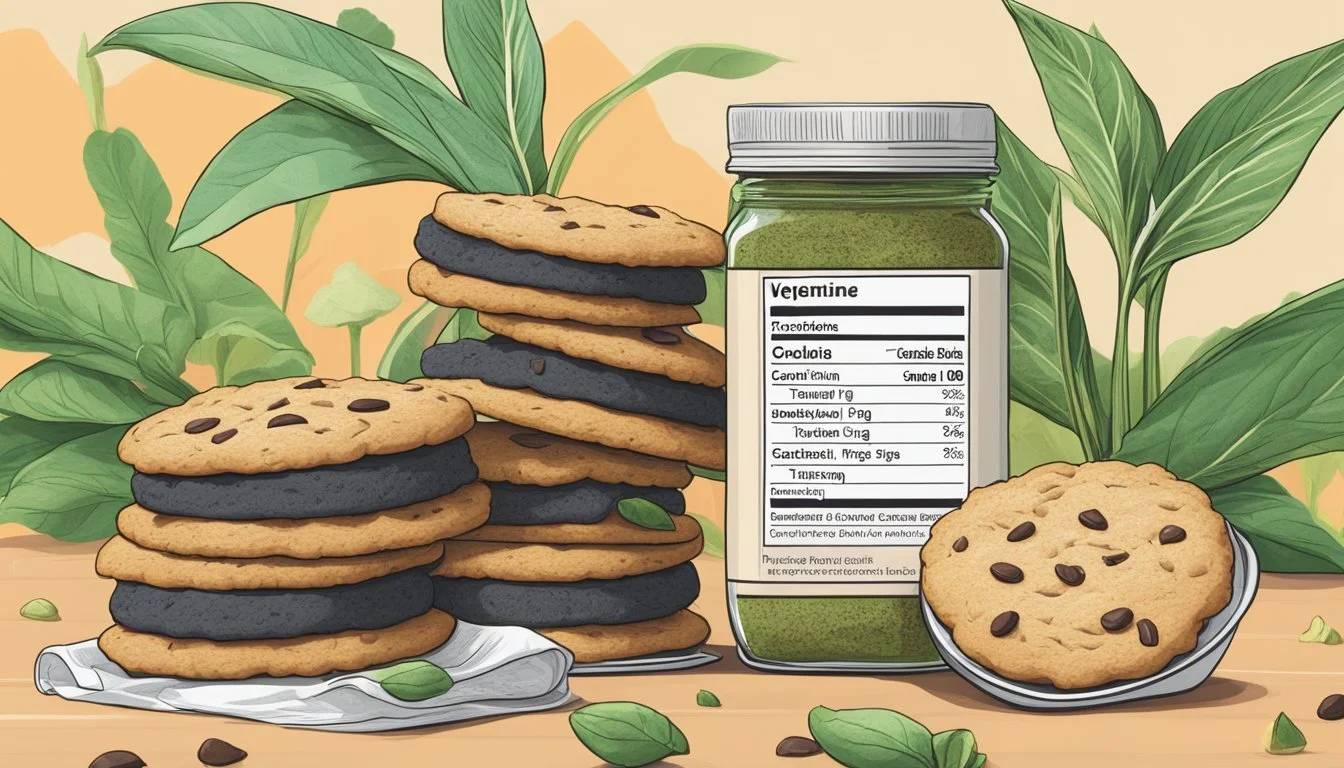Are Florentine Cookies Vegan?
Unveiling the Ingredients
Florentine cookies are traditionally made with ingredients such as butter, honey, and sometimes cream, which are not vegan-friendly. However, with the rising popularity of plant-based diets, there has been an increasing demand for vegan options. This has led to the creation of vegan Florentine cookies using alternative ingredients. Vegan bakers have ingeniously substituted dairy butter with plant-derived butters and honey with vegan sweeteners like maple syrup and agave nectar.
The essence of Florentine cookies lies in their characteristic thin, crispy texture, often combined with nuts and a coating or drizzle of chocolate (What wine goes well with chocolate?). Achieving this delicate crunch without the use of traditional ingredients is a testament to the creativity of vegan baking. Replacements such as almond meal and oatmeal can serve as the base, while vegan chocolate provides the final touch, ensuring that these cookies retain their decadent appeal without any animal-based ingredients.
The process of adapting Florentine cookies to a vegan diet is not only a reflection of changing dietary preferences but also an indication of the versatility of baking. Even as these cookies adhere to the requirements of veganism, they continue to deliver the rich, lacey texture and deep caramel flavors that Florentine cookies are renowned for. Whether served as an elegant dessert or a companion to coffee, vegan Florentine cookies are a delightful treat that can be enjoyed by individuals following a vegan lifestyle without compromising on taste or quality.
What Are Florentine Cookies?
Florentine cookies are a unique dessert known for their sweet, caramel-flavored, and crisp texture. Often studded with nuts and coated with chocolate, they present a delightful contrast of flavors and textures.
History and Origin
Originating from Italy, Florentine cookies, or "Florentines," are believed to date back to the Renaissance period in the city of Florence. They were created as a luxurious treat that showcased the rich flavors of caramel and nuts, which were expensive commodities at the time.
Traditional Florentine Cookie Ingredients
The classic ingredients of a Florentine cookie typically include:
Nuts: Almonds are most commonly used, but some recipes may incorporate other nuts for added flavor.
Butter: This key ingredient contributes to the rich flavor and delicate texture.
Sugar: It caramelizes during baking, giving the cookie its characteristic crispiness.
Flour: Used sparingly, it provides structure.
Chocolate: Many versions dip or coat the bottom of the cookies in chocolate, often dark, to balance the sweetness.
Caramel: Created by the melting of butter and sugar, it acts as a binding agent for the almonds and adds a chewy texture.
Traditionally, these ingredients are combined and baked until golden brown, creating a lace-like appearance. The result is a sophisticated dessert that is both visually appealing and indulgent in taste.
Understanding Veganism
This section provides a factual overview of what constitutes a vegan lifestyle and the dietary choices central to it.
Definition of Vegan
A vegan is an individual who chooses to live a life free of animal products for ethical, environmental, or health reasons. They abstain from all forms of animal exploitation and cruelty, which extends to diet, clothing, and any other purposes.
Vegan Diet Staples
The vegan diet comprises a variety of plant-based foods that are free from dairy, meat, honey, gelatin, and other animal-derived substances. Key staples include:
Proteins: Legumes, nuts, seeds, tofu, and tempeh.
Dairy Alternatives: Vegan butter, soy milk, almond milk, and coconut yogurt.
Whole Grains: Brown rice, quinoa, barley, and whole wheat.
Fruits and Vegetables: A wide array, consumed in abundance for vitamins and minerals.
Healthy Fats: Avocado, olive oil, and nut butters.
Sweets: Vegan chocolate and desserts made without dairy or eggs.
These staples form the foundation of a nutritionally balanced vegan diet, offering alternatives to traditional animal-based foods.
Ingredients in Traditional vs. Vegan Florentine Cookies
Traditional Florentine cookies are known for their delicate, lace-like texture and rich flavor, typically achieved with ingredients unsuitable for a vegan diet. In contrast, vegan Florentine cookies recreate this experience using plant-based substitutes without compromising the cookie's signature characteristics.
Non-Vegan Ingredients to Avoid
Butter: A dairy product made from milk, providing the classic richness and melt-in-the-mouth texture.
Honey: A sweet, viscous substance produced by bees, commonly used for its natural sweetness and binding properties.
Chocolate: Often contains dairy, especially in milk chocolate varieties used for drizzling or as part of the cookie base.
Vegan Substitutes for Common Ingredients
Vegan Butter: A dairy-free alternative typically made from plant oils, which mimics the taste and texture of traditional butter.
Maple Syrup or Agave Nectar: Sweeteners derived from plants that act as a substitute for honey. Both syrup and nectar bring a similar viscosity and can help to bind ingredients together.
Vegan Dark Chocolate: Free from dairy, this chocolate is used for flavoring or decoration while maintaining the cookie's vegan status.
By selecting appropriate replacements such as vegan butter for dairy butter, maple syrup or agave nectar for honey, and vegan dark chocolate instead of chocolate that contains dairy, bakers can enjoy vegan Florentine cookies that honor the essence of the original treat.
Step-by-Step Vegan Florentine Cookie Recipe
This recipe reinvents the classic Florentine cookie with vegan-friendly ingredients, ensuring delightful crispness and flavor. The process includes preparation, baking, and adding a decadent chocolate coating.
Preparation
To begin, one should ensure all ingredients are measured and set to room temperature for consistency. Ingredients typically include vegan butter, a sweetener such as coconut sugar or agave nectar, non-dairy milk, vanilla extract, flour, almond meal, and a pinch of salt, with dark chocolate reserved for the finishing touch.
Preheat the oven to 350°F (176°C).
Line the baking sheets with parchment paper to prevent sticking.
In a small saucepan, combine the vegan butter, sweetener, non-dairy milk, and vanilla extract.
Heat the mixture over medium heat while stirring regularly until the butter melts and ingredients integrate smoothly.
Baking
The next step is to bake the cookies to golden perfection:
Spoon small amounts of batter onto the prepared baking sheet, maintaining space as these cookies will spread.
Flatten each cookie slightly with the back of the spoon if necessary to ensure an even shape.
Place the baking tray in the center rack of the oven.
Bake for 6-8 minutes or until the edges begin to brown.
Finalizing the Cookies
Once baked, the final stage is to add the distinctive chocolate element:
Transfer the cookies to a cooling rack and allow them to cool completely; they will crisp up as they cool.
Melt the dark chocolate in the microwave in 30-second intervals, stirring between each until smooth.
Dip each cookie's bottom in melted chocolate or drizzle it on top.
Allow the chocolate to set at room temperature, which should give a glossy finish to your vegan Florentine cookies.
Tips for Perfect Vegan Florentines
Creating vegan Florentines that are both crunchy and golden brown requires attention to detail in the selection of ingredients, the baking process, and how they are stored. The following tips will guide readers through each step.
Choosing the Right Ingredients
Vegan Butter/Coconut Oil: Opt for a high-quality vegan butter or coconut oil to ensure a rich flavor and proper binding.
Nuts and Dried Fruits (What wine goes well with nuts and dried fruits?): Use a diverse mix such as almonds, cranberries, and apricots for texture and taste. Verify they haven't been processed with non-vegan substances.
Sweeteners: Maple syrup and coconut sugar give a deep flavor and golden color. Always ensure they are 100% pure to maintain the vegan integrity of the cookies.
Flour: A small amount of flour binds the mixture; one can utilize gluten-free flour for a gluten-free version.
Baking Techniques
Oven Temperature: Preheat the oven accurately; typically around 180°C (356°F) or slightly lower for fan-assisted ovens ensures an even bake.
Baking Sheets: Line baking sheets with parchment paper to prevent sticking and achieve an even, golden brown finish.
Thickness: Keep the Florentines thin to ensure a satisfying crunch. Monitoring them closely as they cook is key, as they can go from perfectly golden to burnt quickly.
Storing Vegan Florentines
Cooling: Allow the Florentines to cool completely on the tray to maintain their structure.
Airtight Container: Store them in an airtight container to keep the cookies crisp.
Location: Keep the container in a cool place away from direct sunlight and heat sources to preserve freshness.
Customizing Your Vegan Florentine Cookies
One can enhance the basic vegan Florentine cookie recipe by incorporating a variety of nuts and seeds, as well as dried fruits (What wine goes well with dried fruits?). These additions not only add texture and flavor but also nutritional value.
Nut and Seed Variations
A rich tapestry of tastes and textures can be added by experimenting with various nuts and seeds. Here are specific suggestions for your vegan Florentine cookies:
Almond meal: It serves as the traditional nutty base, offering a fine texture and buttery flavor.
Seeds: Hemp seeds can add crunch and nutritional benefits.
Nut Substitutes:
Crushed almonds or flaked almonds for a classic, crunchy bite.
Pistachios: Chopped pistachios offer a savory contrast with their distinctive flavor and color.
In addition to these, oats can be used to add substance and a chewy bite to the cookies.
Adding Dried Fruits and Flavors
Dried fruits and flavors transform the cookie into a complex treat with each bite. Consider these options to incorporate into the dough:
Dried Fruits:
Apricots: Chopped finely, they provide a subtle tartness.
Cherries: They contribute a sweet and tart flavor, with a chewy texture.
Cranberries: Dried cranberries add a hint of tartness and vibrant color.
Flavors:
Citrus Zest: Orange zest can infuse the cookies with a fresh and tangy aroma.
Spices: A pinch of cinnamon can warm the palette.
Vanilla: A dash of vanilla extract enriches the cookie dough with a sweet and floral aroma.
When customizing, it's important to maintain a balance between the add-ins and the main dough to ensure even baking and a harmonious blend of flavors.
Nutritional Information and Dietary Adaptations
When adapting Florentine cookies for vegan and gluten-free diets, one must consider both the nutritional content of the ingredients used and how substitutions might affect the overall caloric and nutritional profile of the cookies.
Caloric and Nutritional Content per Serving
Florentine cookies, by their traditional recipe, are a confection that typically contains a significant amount of sugar and butter, which contributes to their higher caloric content. When made vegan, substitutes like vegan butter and agave nectar or maple syrup are used. Here's a generalized breakdown for a serving of vegan Florentine cookies (approximately 2 cookies):
Calories: 200-250 kcal
Total Fat: 10-15 grams
Saturated Fat: depends on the type of vegan butter or oil used
Carbohydrates: 25-30 grams
Sugars: 15-20 grams
Protein: 2-4 grams
Fiber: 1-3 grams
The use of almond meal and oatmeal in place of all-purpose flour not only facilitates a gluten-free version but also adds nutritional value in terms of protein and fiber content compared to traditional white flour.
Making Gluten-Free Vegan Florentines
To create gluten-free vegan Florentine cookies, substitutions such as almond meal and gluten-free instant oatmeal are often used instead of all-purpose flour, which contains gluten. These ingredients maintain the cookie's traditional texture while ensuring they are suitable for those with gluten sensitivities. Here's what to consider when making these substitutions:
Almond Meal: Adds a rich, nutty flavor and is an excellent source of Vitamin E and magnesium. Its higher fat content can contribute to a more tender cookie.
Gluten-Free Instant Oatmeal: Ensures the cookies maintain their characteristic lacey texture while providing an additional source of fiber.
Substituting all-purpose flour with gluten-free alternatives like almond meal and instant oatmeal typically does not dramatically alter the caloric value but enhances the nutritional profile with more vitamins, minerals, and fiber.
Presentation and Gifting Ideas
When presenting Florentine cookies, whether as a dessert or snack, the arrangement and packaging can enhance their appeal significantly. This is particularly true if they are being gifted for occasions like Thanksgiving, Christmas, or a birthday party.
Serving Suggestions
For an attractive dessert display, vegan Florentines can be served in edible bowls made from dark chocolate to complement their crispy texture. They can also be arranged on a platter, layered between parchment paper to prevent sticking, and garnished with sliced almonds. To align with the festivity of the occasion, one might consider serving them with a bubbly drink, which contrasts the sweet and nutty flavor profile of the cookies.
Festive Display: Arrange on a decorative plate or within chocolate bowls.
Pairing: Serve with sparkling beverages for a bubbly contrast.
Packaging Vegan Florentines as Gifts
For gifting, vegan Florentines can be placed in eco-friendly boxes or tins, separated by parchment paper squares to maintain their shape and freshness. Adding a personalized touch, such as wrapping with a ribbon and attaching a custom label, could further signify the festive spirit. Additionally, one could include an ingredient card noting the use of dark agave nectar, which is a vegan alternative sweetener used in the cookies, highlighting their vegan quality.
Gift Boxes/Tins: Use environmentally-friendly materials.
Decorative Touches: Ribbons, labels, and ingredient cards enhance personalization.
Advanced Vegan Baking Techniques
In vegan baking, precision and substitution play pivotal roles in emulating textures and flavors traditionally achieved with dairy-based ingredients. Close attention to ingredient interaction and baking science is critical when aiming for the finest results.
Working with Vegan Chocolate
Vegan bakers must be selective when choosing chocolate for their Florentine cookies, often opting for bittersweet or semi-sweet chocolate chips that contain no animal products. One must ensure the purity of chocolate by checking labels, as some products may be contaminated with milk solids. Hannah Kaminsky, a recognized vegan baker, underscores the importance of using quality ingredients.
While melting chocolate, using a double boiler can prevent burning; water should simmer gently, ensuring only steam heats the chocolate, avoiding direct heat. Alternatively, a microwave can be used cautiously at low power settings, stirring every 30 seconds. To achieve a glossy finish, tempering chocolate is a step experienced bakers might use, which requires careful control of chocolate temperature.
Achieving the Perfect Crunch
Creating the characteristic crunch of a Florentine cookie poses a challenge for vegan bakers, as it typically depends on the caramelization of dairy butter and sugar. Innovating with plant-based fats and natural sweeteners, such as coconut oil and agave nectar, can replicate this crunch; controlling moisture and sugar composition is key.
Using silicone baking mats allows for an even heat distribution and a non-stick surface, promoting consistent texture in cookies. After baking, cooling cookies on a rack helps them to crisp evenly, and storing them in an air-tight container ensures they retain their texture. Precise oven temperatures and timing are essential; vegan cookies often require a keen sense of when they are done as they might not brown like traditional cookies.
These advanced techniques can guide a vegan baker to master the art of vegan Florentine cookies with a perfect balance of rich chocolate taste and delightfully crisp texture.







